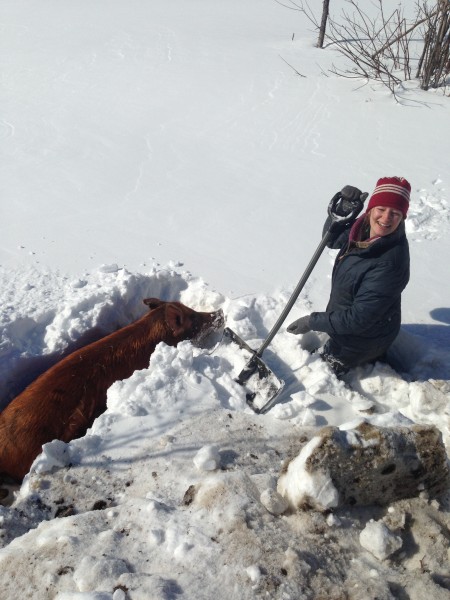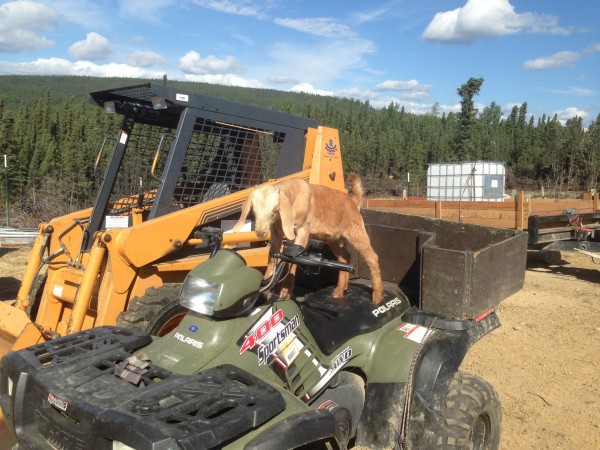Life is good at Perfect Perch Ranch
September 24, 2013

907-474-5042
9/24/13
At Perfect Perch Ranch, Todd and Aleya Brinkman started out gung ho but since having a baby have scaled back their efforts.
“We’re definitely in the pioneer stage,” Todd Brinkman said. “We are learning from our mistakes. We’ve done more wrong than right.”
Brinkman grew up on a horse ranch in western South Dakota, helping his grandfather and uncles herd cattle. He came to Fairbanks in 2003 to earn his doctorate at the University of Alaska Fairbanks. While conducting research on Prince of Wales Island, he met Aleya, a UAF graduate student. They moved to Fairbanks and built a home off the grid on 65 acres in the Murphy Dome area.
Ever since leaving South Dakota, Brinkman wanted to get back into ranching, but this time he is raising goats and hogs instead of horses and cattle. “We have that nice chunk of land and we wanted to do something with it,” he said. “Everybody needs to work hard to bring agriculture to Alaska.”
First he investigated what livestock would work best in Alaska by reading everything he could find. “Goats seemed like a good fit,” he said. “I was surprised more people weren’t doing it.”
He chose the Boer, a meat goat originally from South Africa that came to the U.S. via New Zealand. The muscular, hardy goat is proving suitable for Alaska’s climate. His hogs are Tamworth crosses, known for their foraging habits and ability to survive harsh winters.
Brinkman wishes more people realized the value of goat meat. “Around the world goat meat is the most popular meat,” he said. “But not in the U.S.” The meat is very good, he claims, adding that it is lean, healthy and light. “But it’s not chicken,” he added with a laugh.
While the Brinkmans sell some six-month-old goats for meat, most of their sales are for breeding stock. The goats are so well natured that they accompany the family for berry picking trips. “It’s interesting to watch them select the vegetation,” he said. “They love shrubs.” The swine have been banned from berry picking because they hog all the fruit. The goats are gentle and friendly, but are escape artists.

At one point the ranch had 15 goats but now has only five, along with the six hogs. Brinkman is bringing another boar up this winter in the hopes of cultivating a pure line of Tamworths for Alaska.
When Brinkman figures out how to establish fields out of black spruce forest, he plans to ramp the ranch back up. His main measure of how much to expand the ranch is whether his son Iver, 1, is interested in helping. “When Iver can carry a bucket and decides to engage, that will be the time,” he said. “We moved fast initially but we decided to slow down and not be in a hurry.”
He wants to establish hay fields because the cost of feeding the animals can get prohibitive. “You can build infrastructure like they do in the lower 48 but you never know if it’s going to fit here,” Brinkman said. It’s trial and error all the way with fencing, structures, even water buckets.
The family has a good size garden and greenhouse and will put up a high tunnel next spring. They believe strongly in growing their own food. “Not enough people are aware how vulnerable we are with the amount of food we ship in,” Brinkman said. “Once in a while there is a wakeup call when the store shelves are cleared out but we could do a better job.”
Brinkman finds it deeply satisfying to sit on his deck and observe the animals. “I can watch them for hours and not realize time has passed,” he said. “At the end of the day when everything is fed, happy and quiet, it’s good.”
The couple wants to run the amount of livestock the land can sustain, stop using commercial feed and get in line with the permaculture model, but both work full time and only have so many hours to devote to agriculture. Todd is a research assistant professor for the Scenarios Network for Alaska and Arctic Planning at UAF and Aleya is a wildlife biologist at Fort Wainwright. With his research focus, Brinkman would love to eventually share his land as an experiment site for UAF, running agricultural trials.
“We’re trying not to be too serious about it,” Brinkman said. “It’ll just be fun to raise kids with animals around.”
It takes three to five years to figure out how to make a farm or ranch work, Brinkman said. “We’re not scared to admit we’ve done a lot of things wrong. We just got past our peak frustration period.”
ADDITIONAL CONTACT: toddjbrinkman@gmail.com
This column is provided as a service by the UAF School of Natural Resources and Agricultural Sciences and the Agricultural and Forestry Experiment Station. Nancy Tarnai is the school and station’s public information officer.


